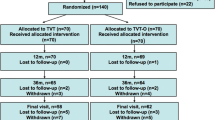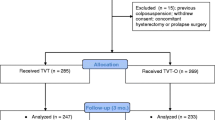Abstract
Introduction and hypothesis
This is a randomized multicenter study comparing two mid-urethra tape procedures, the tension-free vaginal tape (TVT) with the tension-free vaginal tape-obturator (TVT-O) in terms of cure rate and complication rate.
Methods
Seven Finnish hospitals participated. Power calculations required 130 women in each group to detect a 10% difference in cure rate. A total of 267 underwent the allocated operation. Follow-up was scheduled at 2, 12, 36 and 60 months. A cough stress test was used as an objective outcome measure. Subjective outcome was assessed by five different condition-specific quality of life questionnaires.
Results
At 36 months of follow-up, 96% of the patients were evaluated. Objective cure rate was 94.6% in the TVT group and 89.5% in the TVT-O group (p = 0.131). Subjective cure rates were significant with no difference between the groups.
Conclusion
The TVT and the TVT-O are equally effective in the treatment of stress urinary incontinence after 36-month follow-up with no difference in complication rates.


Similar content being viewed by others
References
Ulmsten U, Henriksson L, Johnson P, Varhos G (1996) An ambulatory surgical procedure under local anesthesia for treatment of female urinary incontinence. Int Urogynecol J Pelvic Floor Dysfunct 7:81–85, discussion 85-6
Ulmsten U, Falconer C, Johnson P, Jomaa M, Lanner L, Nilsson CG et al (1998) A multicenter study of tension-free vaginal tape (TVT) for surgical treatment of stress urinary incontinence. Int Urogynecol J Pelvic Floor Dysfunct 9:210–213
Ulmsten U, Johnson P, Rezapour M (1999) A three-year follow up of tension free vaginal tape for surgical treatment of female stress urinary incontinence. Br J Obstet Gynaecol 106:345–350
Nilsson CG, Falconer C, Rezapour M (2004) Seven-year follow-up of the tension-free vaginal tape procedure for treatment of urinary incontinence. Obstet Gynecol 104:1259–1262
Nilsson CG, Palva K, Rezapour M, Falconer C (2008) Eleven years prospective follow-up of the tension-free vaginal tape procedure for treatment of stress urinary incontinence. Int Urogynecol J Pelvic Floor Dysfunct 19:1043–1047
Jarvis GJ (1994) Surgery for genuine stress incontinence. Br J Obstet Gynaecol 101:371–374
Feyereisl J, Dreher E, Haenggi W, Zikmund J, Schneider H (1994) Long-term results after Burch colposuspension. Am J Obstet Gynecol 171:647–652
Tamussino K, Hanzal E, Kolle D, Ralph G, Riss P, Group Austrian Urogynecology Working (2001) The Austrian tension-free vaginal tape registry. Int Urogynecol J Pelvic Floor Dysfunct 12(Suppl 2):S28–S29
Kuuva N, Nilsson CG (2002) A nationwide analysis of complications associated with the tension-free vaginal tape (TVT) procedure. Acta Obstet Gynecol Scand 81:72–77
Kolle D, Tamussino K, Hanzal E, Tammaa A, Preyer O, Bader A et al (2005) Bleeding complications with the tension-free vaginal tape operation. Am J Obstet Gynecol 193:2045–2049
Liapis A, Bakas P, Giner M, Creatsas G (2006) Tension-free vaginal tape versus tension-free vaginal tape obturator in women with stress urinary incontinence. Gynecol Obstet Invest 62:160–164
Meschia M, Bertozzi R, Pifarotti P, Baccichet R, Bernasconi F, Guercio E et al (2007) Peri-operative morbidity and early results of a randomised trial comparing TVT and TVT-O. Int Urogynecol J Pelvic Floor Dysfunct 18:1257–1261
Delorme E (2001) Transobturator urethral suspension: mini-invasive procedure in the treatment of stress urinary incontinence in women. Prog Urol 11:1306–1313
de Leval J (2003) Novel surgical technique for the treatment of female stress urinary incontinence: transobturator vaginal tape inside-out. Eur Urol 44:724–730
Waltregny D, de Leval J (2009) The TVT-obturator surgical procedure for the treatment of female stress urinary incontinence: a clinical update. Int Urogynecol J Pelvic Floor Dysfunct 20:337–348
Araco F, Gravante G, Sorge R, Overton J, De Vita D, Sesti F et al (2008) TVT-O vs TVT: a randomized trial in patients with different degrees of urinary stress incontinence. Int Urogynecol J Pelvic Floor Dysfunct 19:917–926
Schierlitz L, Dwyer PL, Rosamilia A, Murray C, Thomas E, De Souza A et al (2008) Effectiveness of tension-free vaginal tape compared with TOT in women with stress urinary incontinence and intrinsic sphincter deficiency: a randomized controlled trial. Obstet Gynecol 112:1253–1261
Latthe PM, Foon R, Toozs-Hobson P (2007) Transobturator and retropubic tape procedures in stress urinary incontinence: a systematic review and meta-analysis of effectiveness and complications. BJOG 114:522–531
Laurikainen E, Valpas A, Kivela A, Kalliola T, Rinne K, Takala T et al (2007) Retropubic compared with transobturator tape placement in treatment of urinary incontinence: a randomized controlled trial. Obstet Gynecol 109:4–11
Zullo MA, Plotti F, Calcagno M, Marullo E, Palaia I, Bellati F et al (2007) One-year follow-up of tension-free vaginal tape (TVT) and trans-obturator suburethral tape from inside to outside (TVT-O) for surgical treatment of female stress urinary incontinence: a prospective randomised trial. Eur Urol 51:1376–1382, discussion 1383-4
Rinne K, Laurikainen E, Kivela A, Aukee P, Takala T, Valpas A et al (2008) A randomized trial comparing TVT with TVT-O: 12-month results. Int Urogynecol J Pelvic Floor Dysfunct 19:1049–1054
Kauppila A, Alavaikko P, Kujansuu E (1982) Detrusor instability score in the evaluation of stress urinary incontinence. Acta Obstet Gynecol Scand 61:137–141
Stach-Lempinen B, Kujansuu E, Laippala P, Metsanoja R (2001) Visual analogue scale, Urinary incontinence severity score and 15 d–psychometric testing of three different health-related quality-of-life instruments for urinary incontinent women. Scand J Urol Nephrol 35:476–483
Uebersax JS, Wyman JF, Shumaker SA, McClish DK, Fantl JA (1995) Short forms to assess life quality and symptom distress for urinary incontinence in women: the incontinence impact questionnaire and the urogenital distress inventory. Continence program for women research group. Neurourol Urodyn 14:131–139
Rabin R, de Charro F (2001) EQ-5D: a measure of health status from the EuroQol Group. Ann Med 33:337–343
Manca A, Sculpher MJ, Ward K, Hilton P (2003) A cost-utility analysis of tension-free vaginal tape versus colposuspension for primary urodynamic stress incontinence. BJOG 110:255–262
Victor A, Larsson G, Åsbrink AS (1987) A simple patient administered test for objective quantitation of symptoms of urinary incontinence. Scand J Urol Nephrol 21:277–279
Ogah J, Cody JD, Rogerson L (2009) Minimally invasive synthetic suburethral sling operations for stress urinary incontinence in women. Cochrane Database Syst Rev 4:CD006375
Karateke A, Haliloglu B, Cam C, Sakalli M (2009) Comparison of TVT and TVT-O in patients with stress urinary incontinence: short-term cure rates and factors influencing the outcome. A prospective randomised study. Aust N Z J Obstet Gynaecol 49:99–105
Wang W, Zhu L, Lang J (2009) Transobturator tape procedure versus tension-free vaginal tape for treatment of stress urinary incontinence. Int J Gynaecol Obstet 104:113–116
Conflicts of interest
C.G.N. has acted as consultant for Astellas, Ethicon and Pfizer. A.V. has acted as consultant for Astellas Ethicon and Pfizer. This study was instigated by the responsible researchers and funded by University-Administered funds.
Author information
Authors and Affiliations
Corresponding author
Rights and permissions
About this article
Cite this article
Palva, K., Rinne, K., Aukee, P. et al. A randomized trial comparing tension-free vaginal tape with tension-free vaginal tape-obturator: 36-month results. Int Urogynecol J 21, 1049–1055 (2010). https://doi.org/10.1007/s00192-010-1160-y
Received:
Accepted:
Published:
Issue Date:
DOI: https://doi.org/10.1007/s00192-010-1160-y




